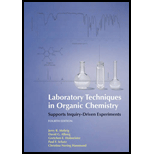
Interpretation:
The reason to obtain only one liquid phase with no interface after the solution is shaken second time should be explained.
Concept introduction:
Immiscible liquids are the liquid system that contains two solvent insoluble with each other and consists of two phases. As both the liquid form a separate layer and does not interact with each, therefore, they are independent of each other and contribute to their own characteristics. Oil and water form two different layers, when mixed with other so these are immiscible in each other.
Explanation of Solution
The aqueous solution of two solvents contains a non-polar ethyl ether and highly polar water. Both the solvents are immiscible with each other due to a very large difference in their density.
As diethyl ether is less dense than water it forms an upper layer in extraction equipment while the water forms a lower layer and solute distributed between aqueous and organic layer according to their solubility. After removal of lower layer, only diethyl ether remains in equipment and addition of another
Want to see more full solutions like this?
Chapter 10 Solutions
Laboratory Techniques in Organic Chemistry
- You were given a mixture of two miscible solvent A and B that you are tasked to separate. You know that solvent A has a boiling point of 49 oC while solvent B has a boiling point of 174 oC. Which of the listed method would overall be the most efficient? Fractional distillation Recrystallization Solid-liquid extraction Liquid-liquid extraction Simple distillation Acid-Base extractionarrow_forwardSilica gel (stationary phase) can potentially interact with analytes by what intermolecular forces?arrow_forwardAcetone and isopropyl alcohol are generally not suitable for use in extraction, but are frequently used as recrystallization solvents. Explainarrow_forward
- Take 100ml of the Foam Bath that contains Sodium Laureth Sulphate Cocamide DEA and add sodium chloride solution in incremental amounts whilst stirring, until more than 5% has been added. Note any physical changes that occur during the addition and stirring process.arrow_forwardWhy the Refractive Index of hexane and heptane from simple distillation closer to the refractive index of hexane and heptane from fractional distillation?arrow_forwardSome procedures include the addition of sodium carbonate before liquid-liquid extraction. What is the purpose of this step?arrow_forward
- Make a results and discussion in Laboratory Report Format of the following: 1. Separation of mixture using different techniques 1.1 Simple distillation: Water + acetone 1.2 Fractional Distillation: Methanol + ethanol 1.3 Chromatography: Separation of mixture of Red ink and blue ink 2. purification of impure samples by crystallization 2.1 Copper sulfate 2.2 Potash alum 2.3 Benzoic acidarrow_forwardWhich of the following statements about fractional distillation are true.? Select all that are True. A)The lower the HETP (height equivalent to a theoretical plate) of the fractionating(packed) column the more efficient it is at separation of components. B)The distillation process involves several concurrent vaporization-condensation cycles. C)Continual change in boiling temperature is observed as the distillation progresses. D)Can ideally separate mixtures with comparable volatilities small BP differences. E)For good separation by distillation the volume of liquid condensing back to the pot should be lower than the volume of liquid distilling off.arrow_forward1. Why should the stopper always be removed from a separatory funnel whenever a liquid is being drained through the stopcock?2. The distribution coefficient, KD (ether/water), between ether and water for aspirin at room temperature is 3.5. What weight of aspirin would be extracted by a single extraction with 60 ml of water from a solution of 10 grams of aspirin in 100 ml of ether? Calculate the weight of aspirin which would be removed by three extractions with 20 ml portions of water.arrow_forward
- What is the main drawback of using steam distillation in the isolation of volatile oils from its matrix?arrow_forwardWhy is the Refractive Index of hexane closer to the refractive index of heptane in both simple and fractional distillation?arrow_forwardWhy should the recrystallization mixture be cooled in an ice bath prior to filtering?arrow_forward
 ChemistryChemistryISBN:9781305957404Author:Steven S. Zumdahl, Susan A. Zumdahl, Donald J. DeCostePublisher:Cengage Learning
ChemistryChemistryISBN:9781305957404Author:Steven S. Zumdahl, Susan A. Zumdahl, Donald J. DeCostePublisher:Cengage Learning ChemistryChemistryISBN:9781259911156Author:Raymond Chang Dr., Jason Overby ProfessorPublisher:McGraw-Hill Education
ChemistryChemistryISBN:9781259911156Author:Raymond Chang Dr., Jason Overby ProfessorPublisher:McGraw-Hill Education Principles of Instrumental AnalysisChemistryISBN:9781305577213Author:Douglas A. Skoog, F. James Holler, Stanley R. CrouchPublisher:Cengage Learning
Principles of Instrumental AnalysisChemistryISBN:9781305577213Author:Douglas A. Skoog, F. James Holler, Stanley R. CrouchPublisher:Cengage Learning Organic ChemistryChemistryISBN:9780078021558Author:Janice Gorzynski Smith Dr.Publisher:McGraw-Hill Education
Organic ChemistryChemistryISBN:9780078021558Author:Janice Gorzynski Smith Dr.Publisher:McGraw-Hill Education Chemistry: Principles and ReactionsChemistryISBN:9781305079373Author:William L. Masterton, Cecile N. HurleyPublisher:Cengage Learning
Chemistry: Principles and ReactionsChemistryISBN:9781305079373Author:William L. Masterton, Cecile N. HurleyPublisher:Cengage Learning Elementary Principles of Chemical Processes, Bind...ChemistryISBN:9781118431221Author:Richard M. Felder, Ronald W. Rousseau, Lisa G. BullardPublisher:WILEY
Elementary Principles of Chemical Processes, Bind...ChemistryISBN:9781118431221Author:Richard M. Felder, Ronald W. Rousseau, Lisa G. BullardPublisher:WILEY





